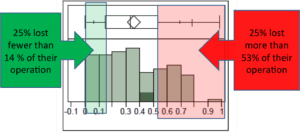Last week was the California Bee Breeder’s Association meeting. Mike, Rob and I attended and Dennis flew in from the East to go. I always enjoy the meetings in a large part because we get to watch all these independent personalities interact. We work with each beekeeper individually and get to know them, but only at the meetings do we really see this bigger image of how they all fit together. Sure, they disagree (and can be pretty vocal about it), but their goals are the same in that they all want to breed the best bees possible. If it helps their bees, they will do it.
The first speaker was Eric Mussen who introduced Dr. Brian Johnson, the new hire at UC Davis. Dr. Johnson briefly described his ideas for what he would like to do at Davis, which included working with beekeepers on health issues and keeping about 500 hives at Davis to produce income for the bee program. His hope is that the income will help make the bee program independently financially secure.

Then we were on. Dennis started with introducing the Bee Informed Partnership and explained how the losses are still at 33%, but fewer are from Colony Collapse Disorder. He talked about how the complexity of the problems and that part of the way he will address this complexity is through conducting surveys to find trends and differences between beekeepers that are having success in keeping colonies alive and those losing vast numbers of bees. Of the beekeepers out there, 25% lost 14% or less of their bees, and 25% lost 53% of their bees or greater. The goal is to help those that are losing the high numbers and reduce those losses by half, saving 86,000 colonies.
Dennis then introduced the Bee Team and Mike, Rob, and I explained our goals and how we plan on getting there. Mike talked about doing small-scale experiments, like testing the efficacy of Fumagillian. Rob talked about what we call “longitudinal monitoring” or following colonies over time. He talked about how this monitoring will give everyone a better idea of what the average levels of disease, mite, and bee populations are at a particular time of year. He discussed the importance of knowing treatment application information in hope that we will find the most efficient treatment regimens. Next, I talked about sampling potential breeder colonies and how this year we want to do a pool of about 100 in Oct-Nov, then return in Jan-Feb and test 50 of the best scoring colonies. We will test for Varroa and Nosema, and score characteristics like frames of bees, brood pattern, color, temperament, and weight. In Jan-Feb, we will include testing for hygienic behavior and viruses. We want to make the process of whittling down the breeding pool to those colonies that appear to have resistance to diseases easy for the beekeepers. Throughout all our talks was an important concept of anonymous data sharing, where we will collect information and provide that information to all the beekeepers but keep identities a secret. Dennis finish by talking about some of the most interesting results from the survey. I’d talk about them here, but a more polished version will come out soon.
We broke for lunch, and after was the business meeting where the price of almonds and queens were discussed, along with the less interesting budget issues.
Overall, I was happy with how the meeting went: the talks went well, I learned some things, chatted with beekeepers, and ate some tri-tip.